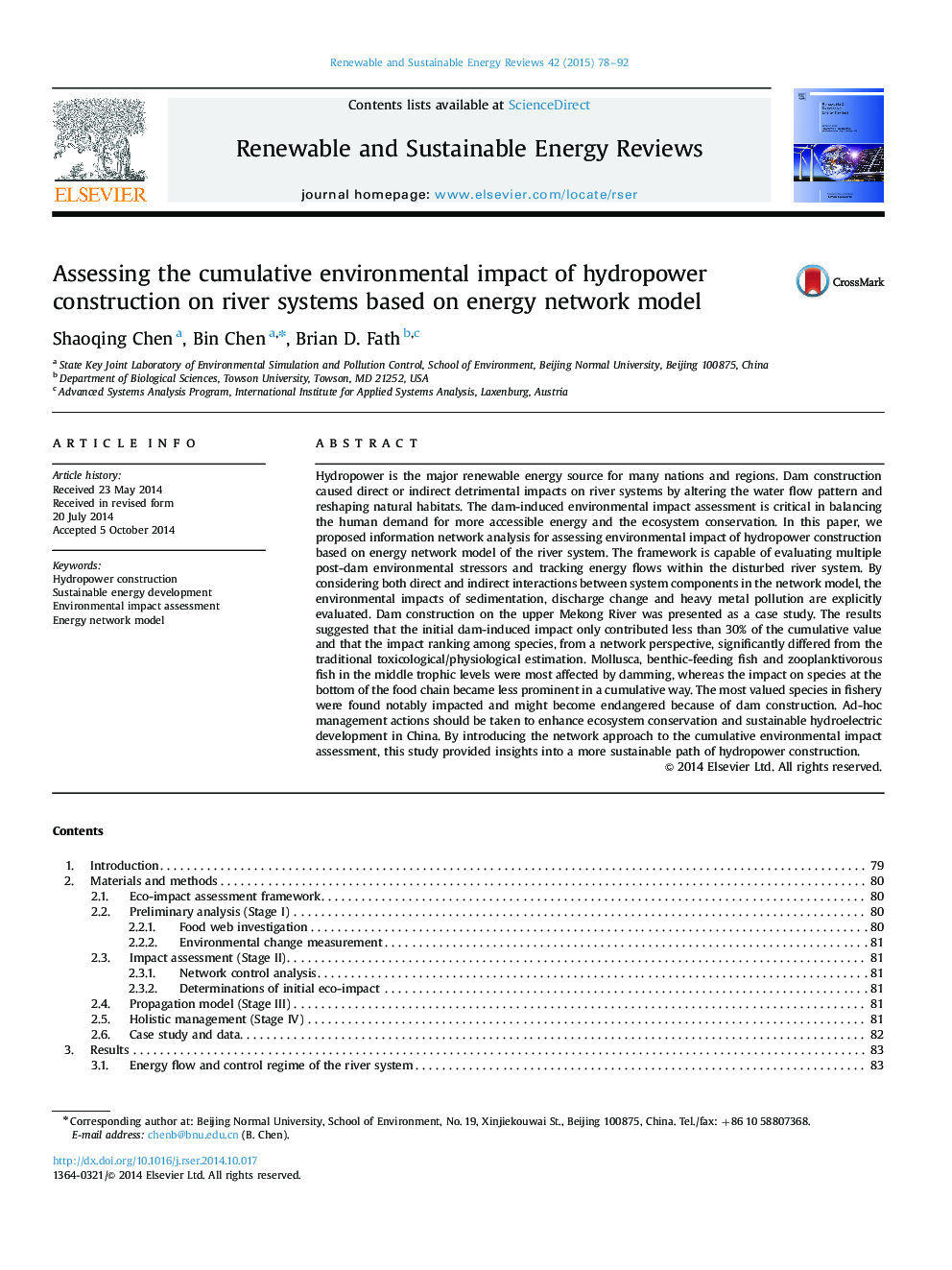| کد مقاله | کد نشریه | سال انتشار | مقاله انگلیسی | نسخه تمام متن |
|---|---|---|---|---|
| 8117600 | 1522343 | 2015 | 15 صفحه PDF | دانلود رایگان |
عنوان انگلیسی مقاله ISI
Assessing the cumulative environmental impact of hydropower construction on river systems based on energy network model
ترجمه فارسی عنوان
ارزیابی اثرات تجمعی زیست محیطی ساخت نیروگاه های آبی در سیستم های رودخانه بر مبنای مدل شبکه انرژی
دانلود مقاله + سفارش ترجمه
دانلود مقاله ISI انگلیسی
رایگان برای ایرانیان
کلمات کلیدی
ساخت آبی، توسعه پایدار انرژی، ارزیابی اثرات زیست محیطی، مدل شبکه انرژی،
ترجمه چکیده
هیدروژن منبع اصلی انرژی تجدیدپذیر برای بسیاری از کشورها و مناطق است. ساخت و ساز سد باعث تاثیر مستقیم یا غیرمستقیم بر سیستم های رودخانه با تغییر الگوی جریان آب و تغییر شکل زیستگاه طبیعی شد. ارزیابی اثرات زیست محیطی ناشی از سد در تعادل نیاز تقاضای انسان برای دسترسی به انرژی بیشتر و حفاظت از اکوسیستم حیاتی است. در این مقاله، تحلیل شبکه اطلاعاتی را برای ارزیابی تأثیرات محیطی ساختمان های برق آبی براساس مدل شبکه انرژی رودخانه انجام دادیم. این چارچوب قادر به ارزیابی تنش های محیطی متعدد پس از سانحه و ردیابی جریان های انرژی در سیستم رودخانه مختلط است. با در نظر گرفتن هر دو تعامل مستقیم و غیر مستقیم بین اجزای سیستم در مدل شبکه، اثرات زیست محیطی رسوب، تغییرات تخلیه و آلودگی فلزات سنگین به صراحت ارزیابی می شود. ساخت سد در رودخانه مکونگ فوقانی به عنوان نمونه موردی ارائه شد. نتایج نشان داد که تأثیر اولیه ناشی از سد فقط کمتر از 30 درصد از ارزش تجمعی را به خود اختصاص داد و تأثیر رتبه بندی بین گونه ها از دیدگاه شبکه به طور معنی داری از برآورد سم شناسی سنتی / فیزیولوژیکی متفاوت بود. ماهی قزل آلا، ماهی دندان شیری و ماهی های زوپوفلکتومی در سطح طوفان وحشی بیشتر تحت تاثیر قرار گرفتند، در حالیکه تاثیر در گونه های پایین زنجیره غذایی به صورت تجمعی کمتر شناخته شد. بیشترین ارزش های موجود در ماهیگیری به طور قابل ملاحظه ای تحت تأثیر قرار گرفتند و ممکن است به دلیل ایجاد سد در معرض خطر قرار گیرند. اقدامات مدیریتی باید به منظور ارتقاء حفاظت اکوسیستم و توسعه هیدرو الکتریکی پایدار در چین صورت گیرد. با معرفی رویکرد شبکه به ارزیابی اثرات تجمعی محیط زیست، این مطالعه بینش هایی را در مورد راه پایدار ساختن نیروگاه های آبی ارائه کرد.
موضوعات مرتبط
مهندسی و علوم پایه
مهندسی انرژی
انرژی های تجدید پذیر، توسعه پایدار و محیط زیست
چکیده انگلیسی
Hydropower is the major renewable energy source for many nations and regions. Dam construction caused direct or indirect detrimental impacts on river systems by altering the water flow pattern and reshaping natural habitats. The dam-induced environmental impact assessment is critical in balancing the human demand for more accessible energy and the ecosystem conservation. In this paper, we proposed information network analysis for assessing environmental impact of hydropower construction based on energy network model of the river system. The framework is capable of evaluating multiple post-dam environmental stressors and tracking energy flows within the disturbed river system. By considering both direct and indirect interactions between system components in the network model, the environmental impacts of sedimentation, discharge change and heavy metal pollution are explicitly evaluated. Dam construction on the upper Mekong River was presented as a case study. The results suggested that the initial dam-induced impact only contributed less than 30% of the cumulative value and that the impact ranking among species, from a network perspective, significantly differed from the traditional toxicological/physiological estimation. Mollusca, benthic-feeding fish and zooplanktivorous fish in the middle trophic levels were most affected by damming, whereas the impact on species at the bottom of the food chain became less prominent in a cumulative way. The most valued species in fishery were found notably impacted and might become endangered because of dam construction. Ad-hoc management actions should be taken to enhance ecosystem conservation and sustainable hydroelectric development in China. By introducing the network approach to the cumulative environmental impact assessment, this study provided insights into a more sustainable path of hydropower construction.
ناشر
Database: Elsevier - ScienceDirect (ساینس دایرکت)
Journal: Renewable and Sustainable Energy Reviews - Volume 42, February 2015, Pages 78-92
Journal: Renewable and Sustainable Energy Reviews - Volume 42, February 2015, Pages 78-92
نویسندگان
Shaoqing Chen, Bin Chen, Brian D. Fath,
